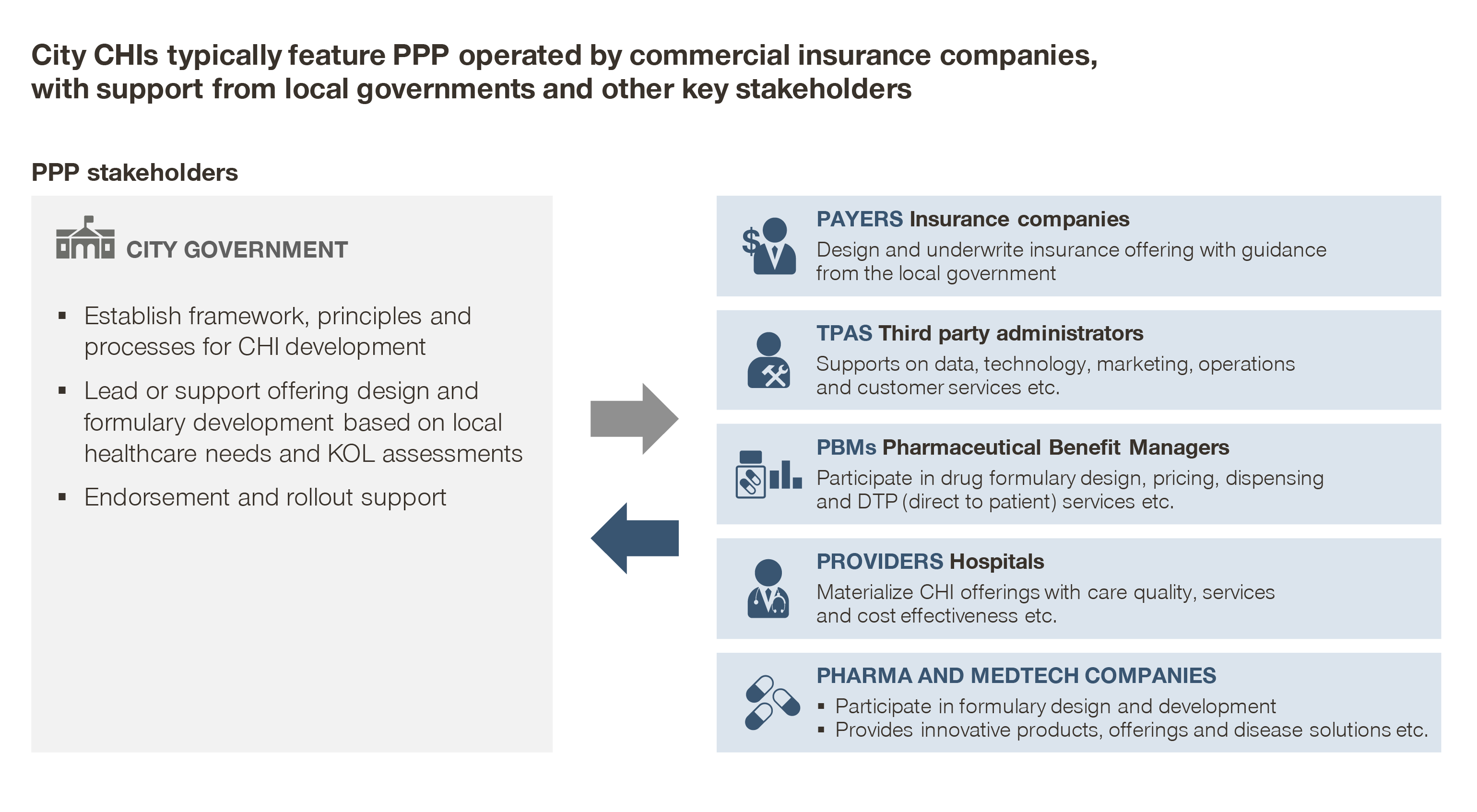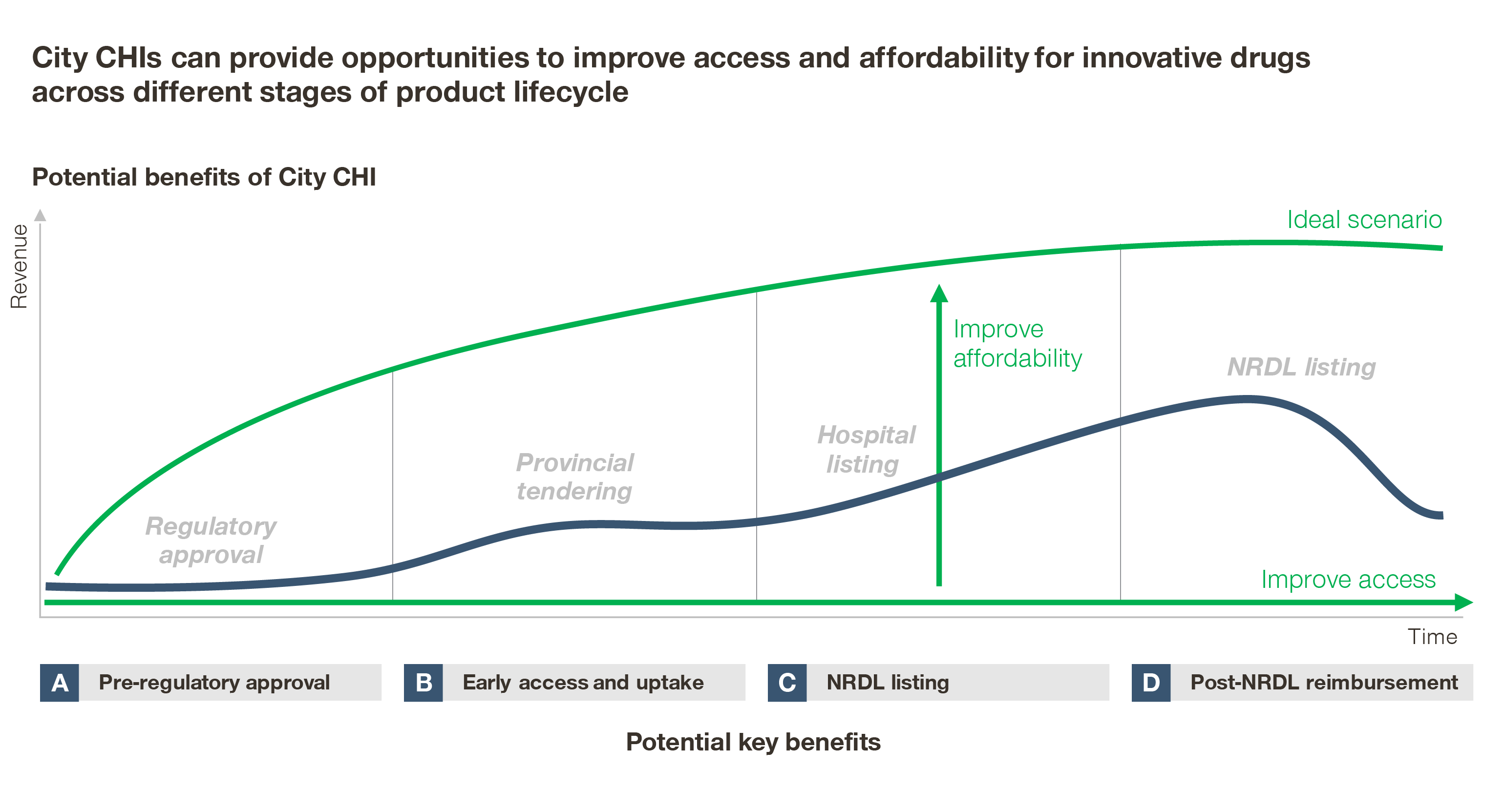Commercial health insurance (CHI) has an increasingly important role to play in China’s healthcare security system. City CHI has been the latest wave taking off across more than 100 major cities, offering new opportunities for innovative therapies to accelerate access and improve affordability. Pharma majors would benefit from a holistic view and forward thinking to assess how CHI fits with their China strategies and plan ahead.
Shanghai launched its city CHI in May 2021, and within two months enrolled over seven million subscribers, or 37 percent of the city’s population.
Shanghai was not the first one to launch its city CHI. In fact, it was a late mover after over 100 cities launched their own versions. There are certain advantages to being late to the party though, as there is an opportunity to learn from the successes and lessons of others, and optimize design and rollout toward maximal impact.
China CHI landscape
Per the government’s grand plan, CHI has always had a role to play in China’s healthcare security system:
- Back in 2009, the State Council issued a number of policies encouraging CHI as a supplement to public reimbursements
- In the official Healthy China 2030 roadmap, the government stated the objectives to establish a comprehensive insurance system by 2030. This included public insurance, CDI, CHI, and medical aid, and expects CHI premium revenue to reach 2 trillion Chinese Yuan (RMB) by 2025
In recent years, CHI has seen strong annual growth at over 30 percent, first driven by major diseases insurances, and then by medical care insurances in different forms.
City CHI first came on to the stage in 2015, with Shenzhen as the first city to launch its pilot. Now, it has been rolled out across 200 cities in China.
City CHIs are designed to address the disease profiles and unmet needs of local populations, as a supplement to public reimbursements – like the National Reimbursement Drug List (NRDL) and critical disease insurances. They typically feature flat annual premiums, meaningful coverages, and strong Public Private Partnerships (PPP) among:
- Commercial insurances
- Local governments
- Third Party Administrators (TPAs)
- Pharmacy Benefit Managers (PBMs)
- Healthcare providers and hospitals
- Pharmaceutical and MedTech companies

While great in concept, city CHI has not immediately become a run-away success.
- When Shenzhen launched its CHI at a mere RMB 30 per year, many questions were raised on its economic viability and sustainability
- Many were quick to point out that Shenzhen features one of the youngest demographics profiles in China, and the big question remains on whether it can be replicated to other cities
Since then, several new versions of city CHI have emerged, with some featuring higher annual premiums in the RMB 100 range, while others pose strict criteria on pre-determined exclusion and renewal terms.
- On the other hand, there are another set of questions on the relevance and meaningfulness of the scheme, especially when it comes to subsets of local populations that need CHI the most, and stood in the way of uptake and rollout
Building on the success factors while addressing the limitations of previous CHIs, the latest wave of CHIs has optimized design and rollout, as seen in the cases of Guangzhou Suisuikang, Hangzhou Xihu Yilian, and Shanghai Huhuibao.
- In particular, these schemes removed the enrollment and renewal restrictions for pre-conditions, making them appealing to the bulk of the population
- At the same time, to ensure economic viability, coverage schemes differ between patients with or without pre-conditions. Shanghai Huhuibao, for example, would offer 70 percent coverage for both inpatient and specialty drug coverage for those without pre-conditions at the time of signing up. Yet only 30-50 percent for those with pre-conditions – which is still meaningful for these patients, while minimizing adverse selections
- In addition, the new schemes typically feature specialty drug formularies that are larger and more diverse than previous versions, including not only oncology drugs, but also rare disease drugs for Huntington’s, Fabry, and others
- Equally important, the new CHIs continue to build on the PPP model, with close collaborations among leading commercial insurance companies, local government agencies, PBMs and TPAs, as well as MNC, and local pharma majors. The strong pull from the enhanced design, combined with the push by local governments were key to the successes of the recent CHI wave
Strategic implications
Leading pharmaceutical and MedTech companies have not been missing out on opportunities with city CHIs:
- Janssen, for example, has had successes with many city CHI formulary listing, with Tracleer, Remicade, Velcade, and Invega listed in Shenzhen, Erleada, Velcade, Stelara, and Ventavis listed in Hangzhou, and Darzalex in Beijing
- Pfizer’s breast cancer drug – Ibrance – received CHI formulary listing in Hangzhou, Suzhou, Shenzhen, Guangzhou, Chengdu, Shanghai, and more, working closely with TPA and PBM stakeholders
- Leading local company, Zai Lab, launched patient assistant programs (PAPs) and charity donations to garner goodwill with local governments. It was successful in listing its ovarian cancer drug – Zejula – and medical device product – Optune – in Suzhou, Hunan, Shanghai, Beijing, Fujian, etc.
Besides achieving access and coverage at city level, as seen in recent NRDL negotiations, city CHI may help innovative therapies with a NRDL listing at a later stage, and facilitate local market access even after a listing.
In addition, the Lecheng CHI at the Hainan medical tourism zone features 75 drugs that haven’t been formally approved in China, and has joint programs with Beijing and Shanxi CHIs, which would help achieve early access and coverage even ahead of National Medical Products Administration (NMPA) approval.

Key imperatives
Capturing city CHI opportunities does require a good understanding of the landscape, as well as strategic foresight, early preparations, and effective engagements with key stakeholders along the CHI value chain.
Moreover, as the China CHI landscape is dynamic and fast evolving, pharmaceutical companies may consider proactively shaping CHIs by exploring and spearheading innovative engagement and intervention models through working closely with potential partners and addressing key unmet needs in China’s healthcare system:
- Toward improving treatment outcomes
- Participating in disease management
- Contributing to health management
In that regard, opportunities are abound, and may go well beyond the immediate benefits of CHI formulary listing city by city.
In summary, CHI will have an increasingly important role to play in China’s healthcare security system, and offers new opportunities for innovative therapies to accelerate access and improve affordability.
Pharma and MedTech majors would benefit from a holistic view and forward thinking approach, to assess how CHI fits with their China strategies and plan ahead.
For the full report, please contact: Shanghai_LS@simon-kucher.com








